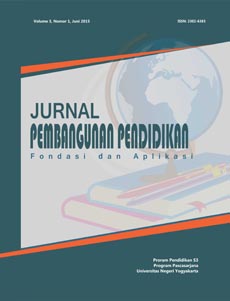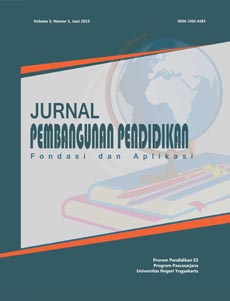EFL students’ perceptions of ProWritingAid as an AI-powered writing support tool: A mixed-methods case study
DOI:
https://doi.org/10.21831/jppfa.v13i1.80668Keywords:
, ProWrittingAid, EFL Students, Writing Skill Improvement, Technology- Enhanced Language Learning, Vocabulary Development, Language Education TechnologyAbstract
This research examines the utilisation of ProWritingAid, an AI-driven writing instrument, by English as a Foreign Language (EFL) students at Universitas Islam Negeri Mataram. The research employs a mixed-methods approach, with 104 participants from several institutions in Lombok, to assess the efficacy of ProWritingAid in enhancing writing skills, specifically in rectifying grammatical errors, improving sentence structure, and advancing vocabulary growth. The results indicate that 53.9% of students had significant vocabulary enhancement, whereas 39.4% noted increased writing confidence. Notwithstanding these favourable results, over 47% of participants expressed uncertainty regarding the tool's overall effect on their writing proficiency, indicating a need for additional investigation. Qualitative data obtained from interviews highlighted the tool's accessibility and user-friendliness, with students often comparing ProWritingAid to a personal writing instructor.Nevertheless, the report also underscores difficulties. Several students indicated challenges with the interface and articulated the necessity for enhanced training to effectively leverage the tool's functionalities. The findings indicate that ProWritingAid has considerable potential as an auxiliary educational tool within Technology-Enhanced Language Learning (TELL) frameworks, although its efficacy relies on user assistance and interface refinement.This research underscores the significance of incorporating technology-based tools into language instruction while tackling user problems. ProWritingAid can improve both academic and personal writing; nevertheless, maximising its advantages necessitates focused training and ongoing enhancements to the platform's usability. Such developments would reinforce its position as a transformative instrument for EFL learners in their pursuit of writing proficiency.
References
Abil Robert, P. K., & Louis Frank. (2024, April 3). The Impact of Artificial Intelligence on Students' Learning Experience by Potter Kaledio, Abill Robert, Louis Frank: SSRN. https://papers.ssrn.com/sol3/papers.cfm?abstract_id=4716747
Ahmad, J. (2016). Technology Assisted Language Learning is a silver bullet for enhancing Language competence and performance: A Case Study. International Journal of Applied Linguistics and English Literature, 5(7), 118–131. https://doi.org/10.7575/aiac.ijalel.v.5n.7p.118
Ali, M., Aini, M. A., & Alam, S. N. (2024). INTEGRATING TECHNOLOGY IN LEARNING IN MADRASAH: TOWARDS THE DIGITAL AGE. Indonesian Journal of Education (INJOE), 4(1), 290–304.
Ariawan, S., Rahmat, H., & Rahman, K. (2021, November).What's Up in Whatsapp Classroom: Exploring Studentsí¢â‚¬TM Perception in Learning Speaking Through Whatsapp during Covid-19 Pandemic | Ariawan | TLEMC (Teaching and Learning English in Multicultural Contexts). https://jurnal.unsil.ac.id/index.php/tlemc/article/view/3581/1912
Ariawan, S., Syarifudin, & Zaikalina, R. (2024). Post Covid-19 Reflection from Indonesian EFL Students on Their Learning Autonomy. The Art of Teaching English as a Foreign Language (TATEFL), 5(2), 162–174. https://doi.org/10.36663/tatefl.v5i2.879
Ariyanto, M. S. A., Mukminatien, N., & Tresnadewi, S. (2019). Students' and Teacher's Perceptions towards the Implementation of ProWritingAid and Teacher Feedback.Jurnal Pendidikan: Teori, Penelitian, Dan Pengembangan, 4(10), 1353. https://doi.org/10.17977/jptpp.v4i10.12843
Borna, P., Mohammadi, R., & Nia, R. (2024).Investigating the Effect of AI Writing Assistance Tools on Iranian Intermediate EFL Learners' Writing Performance: A Comparative Study of ProWritingAid and Grammarly. 12, 478–504. https://doi.org/10.30486/RELP.2024.897162
Defianty, M., Zulfa, S., & Fatwa, Y. (2024, October).Embedding Automated Writing Evaluation in Providing Formative Feedback. https://doi.org/10.15642/NOBEL.2024.15.2.155-170
Dirin, A., Laine, Teemu. H., & Alamäki, A. (2018).Managing Emotional Requirements in a Context-Aware Mobile Application for Tourists.International Journal of Interactive Mobile Technologies (iJIM), 12(2), 177. https://doi.org/10.3991/ijim.v12i2.7933
Elorza, M. M., & Riaza. (2016). Technology-enhanced language learning for specialized domains: Practical applications and mobility. https://www.lltjournal.org/item/854/
Evynurul Laily Zen, M. R. (2023).Errors in Students' Writing (Reports from ProWritingAid) | Rahma | Scope: Journal of English Language Teaching. https://journal.lppmunindra.ac.id/index.php/SCOPE/article/view/15528
Fitria, T. N. (2021). ARTIFICIAL INTELLIGENCE (AI) IN EDUCATION: USING AI TOOLS FOR TEACHING AND LEARNING PROCESS. Prosiding Seminar Nasional & Call for Paper STIE AAS, 4(1), Article 1.
Fitria, T. N. (2023). Artificial intelligence (AI) technology in OpenAI ChatGPT application: A review of ChatGPT in writing English essay. ELT Forum: Journal of English Language Teaching, 12(1), Article 1. https://doi.org/10.15294/elt.v12i1.64069
Gashı Shatrı, Z., & Shatrı, Z. G. (2020). Advantages and disadvantages of using ınformation technology in learning process of students. Journal of Turkish Science Education, 17(3), 420–428. https://doi.org/10.36681/
Jones, G., & Robert. (2011, January 6). Mobile apps for language learning. https://www.lltjournal.org/item/572/
Kholidi, M., Ariawan, S., & Auni, N. (2024).DIGITAL LITERACY PRACTICES OF ENGLISH AS A SECOND LANGUAGE STUDENTS: A CASE STUDY AT MARA UNIVERSITY OF TECHNOLOGY MALAYSIA. 104–119. https://doi.org/10.17576/ajtlhe.1601.2024.07
Kirana, A., Kembaren, F. R. W., & Hz, B. I. R. (2024). The Influence of DeepL Translator On EFL Students' Writing. Jurnal Ilmu Sosial, Humaniora Dan Seni, 3(1), Article 1.
Marquardt, M. J., & Kearsley, G. (2024).Technology-Based Learning: Maximizing Human Performance and Corporate Success. CRC Press.
Maulidina, P., & Wibowo, H. (2022).THE USE OF GRAMMARLY TOOLS TO ENRICH STUDENT'S WRITING ABILITY.Lingua, 18(2), Article 2. https://doi.org/10.34005/lingua.v18i2.2246
Muhammad Ismail, W. (2022).The effectiveness of Grammarly and ProWritingAid application toward writing skill across students writing level of MAN Batu students Etheses of Maulana Malik Ibrahim State Islamic University. http://etheses.uin-malang.ac.id/36341/
Mulyadi, D., Singh, C. K. S., Setiawan, A., & Prasetyanti, D. C. (2023). Technology-enhanced task-based language teaching toward their self-directed language learning: ESP learners' views. Studies in English Language and Education, 10(3), Article 3. https://doi.org/10.24815/siele.v10i3.27910
Osama Koraishi. (2023, December 5). Teaching English in the Age of AI: Embracing ChatGPT to Optimize EFL Materials and Assessment | Language Education and Technology. https://langedutech.com/letjournal/index.php/let/article/view/48
Pratama, M. P., Sampelolo, R., & Lura, H. (2023).REVOLUTIONIZING EDUCATION: HARNESSING THE POWER OF ARTIFICIAL INTELLIGENCE FOR PERSONALIZED LEARNING.KLASIKAL : JOURNAL OF EDUCATION, LANGUAGE TEACHING AND SCIENCE, 5(2), Article 2. https://doi.org/10.52208/klasikal.v5i2.877
Schmidt-Fajlik, R. (2023). ChatGPT as a Grammar Checker for Japanese English Language Learners: A Comparison with Grammarly and ProWritingAid. AsiaCALL Online Journal, 14(1), Article 1. https://doi.org/10.54855/acoj.231417
Syarifudin, Dr., & Ariawan, S. (2021). Technology in English Language Teaching"¬. https://scholar.google.com/citations?view_op=view_citation&hl=en&user=zkM20D0AAAAJ&cstart=20&pagesize=80&citation_for_view=zkM20D0AAAAJ:eQOLeE2rZwMC"¬
Tira Nur Fitria. (2021). QuillBot as an online tool: Students' alternative in paraphrasing and rewriting of English writing | Fitria | Englisia: Journal of Language, Education, and Humanities. https://jurnal.ar-raniry.ac.id/index.php/englisia/article/view/10233
Tongco, M. D. C. (2007). Purposive Sampling as a Tool for Informant Selection.Ethnobotany Research and Applications, 5, 147–158.
Wahyuda, M. I., & Putera, A. A. (2022a).THE EFFECTIVENESS OF PROWRITINGAID TOWARD STUDENTS WRITING SKILLS IN SENIOR HIGH SCHOOL.English Edu: Journal of English Teaching and Learning, 1(1), 26–34. https://doi.org/10.18860/jetl.v1i1.1624
Wahyuda, M. I., & Putera, A. A. (2022b).THE EFFECTIVENESS OF PROWRITINGAID TOWARD STUDENTS WRITING SKILLS IN SENIOR HIGH SCHOOL.English Edu: Journal of English Teaching and Learning, 1(1), 26–34. https://doi.org/10.18860/jetl.v1i1.1624
Yang, S. C., & Chen, Y.-J. (2007). Technology-enhanced language learning: A case study. Computers in Human Behavior, 23(1), 860–879. https://doi.org/10.1016/j.chb.2006.02.015
Published
How to Cite
Issue
Section
Citation Check
License
Copyright (c) 2025 Jurnal Pembangunan Pendidikan: Fondasi dan Aplikasi

This work is licensed under a Creative Commons Attribution-ShareAlike 4.0 International License.
The Authors submitting a manuscript do so on the understanding that if accepted for publication, copyright publishing of the article shall be assigned to Jurnal Pembangunan Pendidikan: Fondasi dan Aplikasi
 | Jurnal Pembangunan Pendidikan: Fondasi dan Aplikasi by https://journal.uny.ac.id/index.php/jppfa is licensed under a Creative Commons Attribution-ShareAlike 4.0 International License. |













